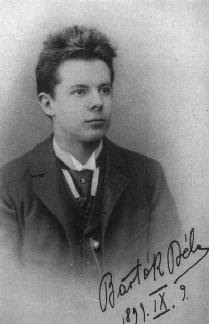
[Bartok at his high school graduation]
Béla [Viktor János] Bartók (in Hungarian usage "Bartók Béla" March 25, 1881 - September 26, 1945) was born in the small Banatian town of Nagyszentmiklós in Austria-Hungary (now Sânnicolau Mare, Romania). He displayed notable musical talent very early in life: according to his mother, he could distinguish between different dance rhythms that she played on the piano even before he learned to speak in complete sentences. By the age of four, he was able to play 40 songs on the piano, and his mother began formally teaching him the next year.
Béla was a small and sickly child, and suffered from a painful chronic rash until the age of five . In 1888, when he was seven, his father (the director of an agricultural school) died suddenly, and Béla's mother then took him and his sister Erzsebet to live in Nagyszőlős (today Vinogradiv, Ukraine), and then to Pozsony (Bratislava, Slovakia).
In Pressburg (Pozsony) Béla gave his first public recital at 11 to a warm critical reception. Among the pieces he played was his own first composition, written two years previously: a short item called The Course of the Danube. Shortly thereafter he was accepted as a student of László Erkel.
He studied piano under István Thoman (a former student of Franz Liszt) and composition under János Koessler at the Royal Academy of Music in Budapest from 1899 to 1903.
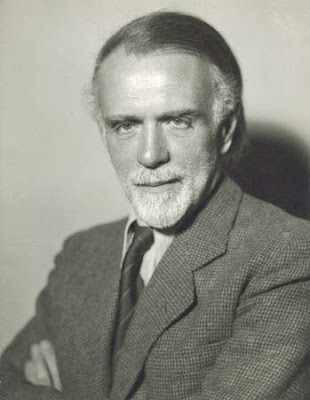
There he met Zoltán Kodály, who influenced him greatly and become his lifelong friend and colleague.
It was the music of Richard Strauss, whom he met at the Budapest premiere of Also Sprach Zarathustra in 1902, that had the most influence on his early work.
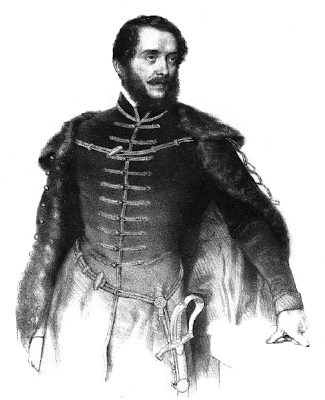
In 1903, Bartók wrote his first major orchestral work, Kossuth, a symphonic poem which honored Lajos Kossuth, hero of the Hungarian revolution of 1848.
Raised as a Roman Catholic, Bartók had by this year early adulthood (22) become an atheist, and considered the existence of God as undecidable and unnecessary.
***
Rhapsody for Piano and Orchestra, Op. 1 (1903)
Scherzo Burlesque for Piano and Orchestra, Op. 2 (1904)
Suite No. 1 for full orchestra, Op. 3 (1905)
Suite No. 2 for small orchestra, Op. 4 (1906)
***
From 1907, his music also began to be influenced by the music of Claude Debussy that Kodály had brought back from Paris.
In that year, Bartók began teaching as a piano professor at the Royal Academy. This position freed him from touring Europe as a pianist and enabled him to stay in Hungary. Among his notable students were Fritz Reiner, Sir Georg Solti, György Sándor, Ernő Balogh, Lili Kraus, and, after Bartók moved to the United States, Jack Beeson and Violet Archer.
It was at the Academy that he met the talented violin student Stefi Geyer, with whom he formed a deep attachment. But before long, their relationship ran into difficulties, largly as a result of their conflicting attitudes towards religion.
In September 1907 Bartok wrote two letters to Geyer in which he expounded his views with missionary zeal. In the first of these (which runs to four thousand words), despite correctly predicting that his beloved (a devout Christian) would find it hard to sympathize with his position, Bartok nevertheless spent many pages attempting to convince her of the emptiness of religion, and signed the letter "Greetings from AN UNBELIEVER (who is more honest than a great many believers)."
Geyer's reply has not survived, but its gist may be surmised from Bartok's next letter, in which he confesses how upset he was at her reaction. While refusing to backtrack, he admits to a certain inner loneliness. "After reading your letter, I sat down at the piano -- I have a sad misgiving that I shall never find any consolation in life except in music, and yet..." This is followed by a musical quotation contating the four-note opening motif of the Violin Concerto No. 1 (1908), over which Bartok writes: "This is your Leitmotiv."
Completing the score on February 5, the composer inscribed it, "For Stefi, from the times that were happy ones -- although even that was only half-happiness," and in letters written at about this time he declared "I wrote it straight from the heart... the first movement is my confession to you."
He sent the manuscript (not a copy!) to her as a token of his love and, as if to underline his point about humanity's essential loneliness, added a long poem by Bela Balazs to the last pages of the score, the general idea being the futility of relying on others for happiness ("No two stars are as far apart as two human souls"). The choice of poet is significant: it was Balazs who later provide the times for Bartok's opera Bluebeard's Castle and ballet The Wooden Prince, two works which dwell further on the difficulties of communication between the sexes.
The relationship with Geyer finally disintegrated during th espring of 1908, and, by the time her leitmotiv reappeared in the last two of the 14 Bagatelles, Op. 6 (May 1908), it had acquired thoroughly negative connotations, somewhat in the manner of the transformation of Hector Berlioz's idee fixe in the Symphonie Fantastique fifth movement. 13 is inscribed "Elle est morte" ("She is dead"), while 14, a mocking waltz which burlesques Geyer's theme, is perhaps the "hateful music" the composer had earlier said would represent the "cool, indifferent, silent Stefi Geyer."
Back in January, Bartok had still intended to write a three-movement concerto, but soon after this decided that the two contrasting movemnts already composed -- the first "a musical portrait of the idealized Stefi Geyer, transcendant and intimate," the second "The lively Stefi Geyer, gay, wity, and entertaining" -- could stand on thier own.
This concerto was destined to remain unperformed until after Geyer's death, when the manuscript was discoverd among her possessions.
The 14 Bagatelles also show Bartok's growing interest in folk music. Probably the first piece to show clear signs of this new development is the String Quartet No. 1 in A Minor (1908).
Yet Bartok could not quite let go of the music associated with Steffi Geyer, creating a new piece -- Two Portraits (1908), Op. 5 -- out of pre-existent movement. Portrait No. 1, "One Ideal," is practically identical with the first movment of the Violin Concerto No. 1, while No. 2, "One Grotesque," is an orchestrated version of the Bagatelle No. 14.
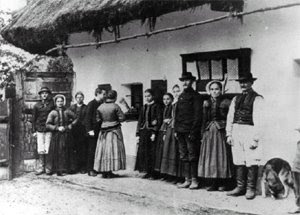
Also in 1908, inspired by both their own interest in folk music and by the contemporary resurgence of interest in traditional national culture (and to forget about Geyer?), Bartok and Kodály undertook an expedition into the countryside to collect and research old Magyar folk melodies. Their findings came as somewhat of a surprise: previously, most people had considered Magyar folk music to be Gypsy music. The classic example of this misperception is Franz Liszt's famous Hungarian Rhapsodies for piano, which were actually based on popular art-songs performed by Gypsy bands of the time.
In contrast, the old Magyar folk melodies discovered by Bartók and Kodály bore little if any resemblance to the popular music performed by these Gypsy bands. Instead, many of the folk-songs they found to be based on pentatonic scales similar to those in various Oriental folk traditions, notably those of Central Asia and Siberia. Kodály later discovered striking parallels between some ancient Magyar songs and songs of the Mari and Chuvash peoples of western Siberia.
Bartók and Kodály quickly set about incorporating elements of this authentic Magyar peasant music into their compositions. While Kodály frequently quoted folk songs verbatim and wrote pieces derived entirely from authentic folk melodies, Bartók's style was more of a synthesis of folk music, classicism, and modernism. He rarely used actual peasant melodies in his compositions, but his melodic and harmonic sense was still profoundly influenced by the folk music of Hungary, Romania, and many other nations, and he was especially fond of the asymmetrical dance rhythms and pungent harmonies found in Bulgarian music.
In 1909, Bartók married Márta Ziegler.

Their son, Béla II, was born in 1910.
***
Two Pictures, Op. 10 (1911)
***
In 1911, Bartók wrote what was to be his only opera, Bluebeard's Castle, dedicated to his wife. He entered it for a prize awarded by the Hungarian Fine Arts Commission, which rejected it out of hand as un-stageworthy.
***
Four Pieces for Orchestra (1912) Op. 12
I. Preludio: Moderato
II. Scherzo: Allegro
***
After his disappointment over the Fine Arts Commission prize, Bartók wrote very little for two or three years, preferring to concentrate on collecting and arranging folk music.
He collected in the first place in the Carpathian Basin (the then Kingdom of Hungary), this included Hungarian, Slovakian, Romanian and Bulgarian folk music. He also collected in Moldavia, Wallachia and in 1913 in Algeria.
The outbreak of World War I forced him to stop these expeditions, and he returned to composing, writing the ballet The Wooden Prince (1916) and the String Quartet No. 2 (1917), the former giving him some degree of international fame.
Bartok became attracted to Unitarianism, and publicly converted to the Unitarian faith in 1916. His son later became president of the Hungarian Unitarian Church.
***
Romanian Folk Dances for small orchestra (1917)
***
In 1917 Bartók revised the score to Bluebeard's Castle in preparation for its 1918 première, rewriting the ending. Following the 1919 revolution, he was pressured by the government to remove the name of the blacklisted librettist Béla Balázs (by then a refugee in Vienna) from the opera; it received only one revival (1936) before he emigrated. For the remainder of his life, although he was passionately devoted to Hungary, its people and culture, he never felt much loyalty to its government or official establishments.
The cataloguing of Bartók's works is somewhat complex. Bartók assigned opus numbers to his works three times, the last of these series ending with the Improvisations Op. 20 in 1920. He ended this practice because of the difficulty of distinguising between original works and ethnographic arrangements, and between major and minor works.
He subsequently worked on another ballet, The Miraculous Mandarin, following this up with two violin sonatas (written in 1921 and 1922 respectively). Mandarin was started in 1918, but not performed until 1926 because of its sexual content, a tory of prostitution, robbery, and murder.

***
The Miraculous Mandarin (1919)
I. Beginning
II. The Curtain Rises
III. First Seduction Game
IV. Second Seduction Game
V. Third Seduction Game
VI. The Mandarin Enters
VII. Dance of the Girl
VIII: The Chase
***

Bartók divorced Márta in 1923, and married a piano student, Ditta Pásztory.
***
Dance Suite (1923)
***
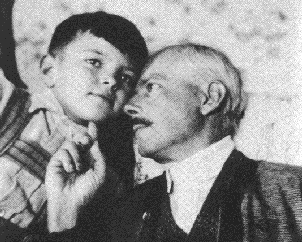
His second son, Péter, was born in 1924.
Bartók's composition for piano Mikrokosmos Sz. 107, BB 105 consists of 153 progressive pieces in six volumes written between 1926 and 1939. The individual pieces progress from very easy and simple beginner etudes to very difficult advanced technical displays, and are used in modern piano lessons and education. In total, according to Bartók, the piece "appears as a synthesis of all the musical and technical problems which were treated and in some case only partially solved in the previous piano works." Volumes one and two are dedicated to his son Péter, while volumes five and six are intended as professionally performable concert pieces.
Volumes I-II: Pieces 1-36 and 37-66, beginner
Volumes III-IV: Pieces 67-96 and 97-121, moderate to advanced
Volumes V-VI: 122-139 and 140-153, professional
***
Piano Concerto No. 1 (1926)
I.
II.
III.
***
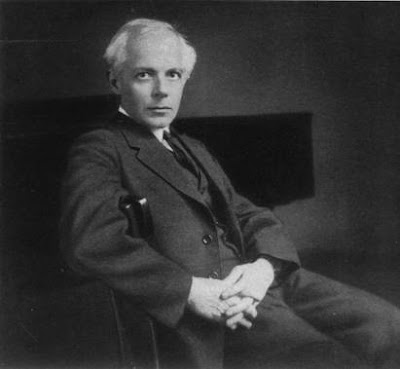
He wrote his third and fourth string quartets in 1927–28, starting to incorporate folk music influences broadly in his compositions.
***
Rhapsody Folk Dances for Violin and Orchestra No. 1 (1929)
Piano Concerto No. 2 (1932)
***
The String Quartet No. 5 (1934) is written in somewhat more traditional style.
***
Rhapsody Folk Dances for Violin and Orchestra No. 2 (1935)
***
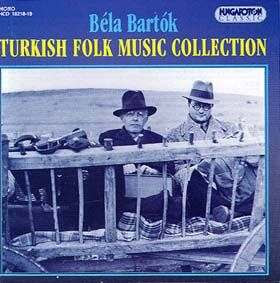
He returned to collecting folksong in 1936 in Turkey.
One characteristic style of music is his "Night Music," which he used mostly in slow movements of multi-movement ensemble or orchestra compositions in his mature period. It is characterised by "eerie dissonances providing a backdrop to sounds of nature and lonely melodies."
The third movement of his Music for Strings, Percussion and Celesta (Adagio) features in the suspense movie The Shining and is a clear example of Night Music style.
***
Music for Strings, Percussion, and Celesta (1936)
I.
II.
III.
IV.
***
Violin Concerto No. 2 (1938)
***
Bartók wrote his sixth and last string quartet in 1939.
***
Divertimento for strings (1939).
***
In 1940, as the European political situation worsened after the outbreak of World War II, Bartók was increasingly tempted to flee Hungary.
Bartók was strongly opposed to the Nazis and their Hungarian cronies. After they came into power in Germany, he refused to give concerts there and switched away from his German publisher. His liberal views caused him a great deal of trouble from conservatives in Hungary.
Having first sent his manuscripts out of the country, Bartók reluctantly emigrated to the U.S. with Ditta, settling in New York City. Péter joined them in 1942 and later enlisted in the United States Navy. Béla, Jr., remained in Hungary.
Bartók never became fully comfortable in the U.S. and initially found it difficult to compose. Although well-known in America as a pianist, ethnomusicologist, and teacher, he was not well known as a composer, and there was little interest in his music during his final years. He and his wife gave concerts, and for several years, supported by a research grant, they worked on their large collection of Yugoslav folk songs.
Bartók's difficulties during his first years in the US were mitigated by publication royalties, teaching, and performance tours. While their finances were always precarious, it is a myth that he lived and died in poverty and neglect. There were enough supporters to see to it that there was money and work available. A proud man, Bartók generally refused outright charity. Though he was not a member of ASCAP, the society paid for any medical care he needed in his last two years and Bartók accepted this.
The first symptoms of his leukemia began in 1940, his right shoulder began to show signs of stiffening. In 1942 these symptoms increased and he started having bouts of fever. Medical examinations failed to diagnose the disease. Finally, in April 1944, he was diagnosed with leukemia but, by this time, little could be done.
Even as his body was wasting away, Bartók's compositional energy reawakened one last time, and he produced a final set of masterpieces, partly thanks to the violinist Joseph Szigeti and the conductor Fritz Reiner (who had been Bartók's friend and champion since his days as Bartók's student at the Royal Academy). Bartók's last work might well have been the String Quartet No. 6, were it not for Serge Koussevitsky commissioning him to write the Concerto for Orchestra for Koussevitsky's Boston Symphony Orchestra, which premièred the work in December 1944 to overwhelming and glowing reviews. This quickly became Bartók's most popular work, although he did not live to see its full impact.
Concerto for Orchestra (1943)
I. Introduzione
II. Giuoco delle coppie
III. Elegy
IV. Intermezzo Interrotto
V. Finale
***
He was also commissioned in 1944 by Yehudi Menuhin to write a Sonata for Solo Violin.
***
For Children (1945)
Quasi Adagio
***
Bartók went on in 1945 to write his Piano Concerto No. 3, a graceful and almost neo-classical work for his wife, and begin work on his Viola Concerto, for William Primrose, to whom Bartok wrote on September 8:
"Most probably some passage will prove to be uncomfortable or unplayable. These wiwe will discuss later, accodingto your observations."
This consultation never took place. Primrose drove from Philadelphia to meet with Bartok, but when he arrived at the composer's New York apartment at 309 West 57th Street (about two blocks west of Carnegie Hall), it was raining heavily, and he was unable to find a place to park!

Primrose thus drove on to his ultimate destination in New England, intending to reschedule the meeting during his return trip But before this could occur, Bartok died at 64 from leukemia (secondary polycythemia) on September 26 in West Side Hospital.
He left Piano Concerto No. 3 and the Viola Concerto unfinished, both of which were later completed by his pupil, Tibor Serly, the latter also arranged for cello. The viola piece was completed from rough notes left by Bartők and never really accepted as a full work. It was revised and polished in the 1990's by Peter Bartók and some consider this to be a bit closer to what the composer may have intended.

[Bartók on 1000 Hungarian forint banknote (1983)]
Bartok's body was initially interred in Ferncliff Cemetery in Hartsdale, New York, but during the final year of communist Hungary in the late 1980's, his remains were transferred to Budapest, Hungary for a state funeral on July 7, 1988 with interment in Budapest's Farkasréti Cemetery.
There is a statue of Béla Bartók in Brussels, Belgium near the central train station in a public square, Spanjeplein-Place d'Espagne, and another in London, opposite South Kensington Underground Station. There is a third statue in front of one of the houses (now a museum) that Bartók owned in the hills above Budapest.
Since his death, two full and one partial attempts at cataloguing have been made. The first, and still most widely used, is András Szöllősy's chronological Sz. numbers, from 1 to 121. Denijs Dille subsequently reorganized the juvenilia (Sz. 1-25) thematically, as DD numbers 1 to 77. The most recent catalogue is that of László Somfai; this is a chronological index with works identified by BB numbers 1 to 129, incorporating corrections based on the Béla Bartók Thematic Catalogue.
[8882 Stravinsky / 8881 Bartok / 8880 Ukelele]
